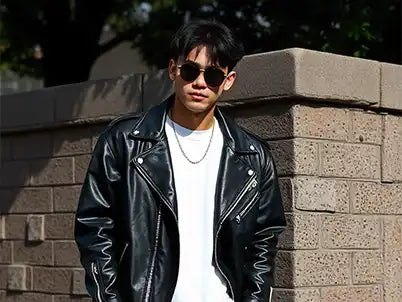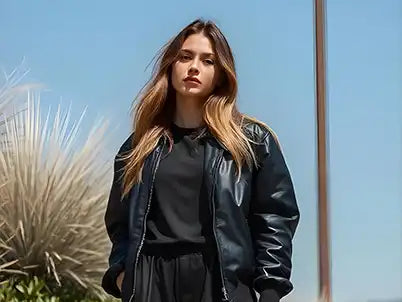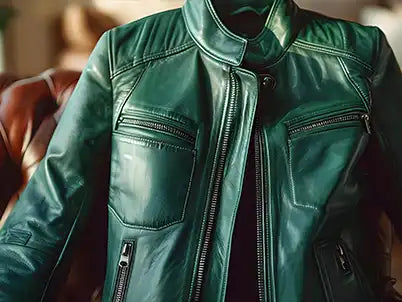As temperatures drop and winter sets in, selecting an insulated jacket becomes essential to staying stylish yet warm and cozy during winter's chilliest temperatures. While there are various choices, three main contenders for insulation options include down, synthetic, and leather options; each provides specific advantages tailored to meet specific needs.
This guide will explain insulated jackets and compare different types to help you choose the perfect one for your winter wardrobe.
What Is an Insulated Jacket?

An insulated jacket is designed to retain body heat and keep you warm in cold conditions, using materials like down, synthetic fibers or thermal linings that trap body heat for warmth even under extreme temperatures. By creating an airtight seal against heat escaping outward, these jackets ensure maximum comfort even in extreme climates.
How Does Insulation Work?
At its core, insulation works by trapping air. Insulated jackets use materials that create small air pockets which act as barriers against body heat escaping and thus keep warm air trapped inside of them. Here’s how the three primary types of insulation achieve this:

Down Insulation:
- It is constructed from the soft undercoat of ducks or geese. Clusters of down hold warmth in.
- Light and very compressible, they work well in extreme sub-zero temperatures.
Synthetic Insulation:
- Crafted of polyester fibers, synthetic insulation offers the warmth of down while still being an insulating factor when damp.
- Activewear made of cotton is an increasingly popular choice due to its durability and cost effectiveness.
Leather with Thermal Lining:
- Leather jackets featuring insulated linings offer the best of both styles: style and warmth.
- Leather's natural strength offers wind and moisture protection, while its warm lining provides warmth in colder environments.
Down Insulation: Warmth and Luxury

Advantages of Down Jackets
- Exceptional Warmth: Down offers an unrivaled warmth-to-weight ratio, making it perfect for extremely cold conditions.
- Lightweight and Packable: Perfect for travelers, down jackets can easily fit into small spaces when being packed up or carried when traveling.
- Long-Lasting: With proper maintenance, quality down jackets can last decades.
Disadvantages of Down Jackets
- Poor Performance When Wet: Because of the insulate properties, when the down gets wet, it will lose some of its insulating value, except if treated with water repellent coatings to protect it against the entry of water.
- Cost: Down jackets will tend to be quite expensive simply due to the quality and craftsmanship of materials used.
- Ethical Concerns: Concerns over animal welfare which arise with the sourcing of down have made some look for synthetic alternatives as a humane option.
Synthetic Insulation: Versatile and Reliable

Advantages of Synthetic Jackets
- Water Resistance: Synthetic insulation does not lose its thermal properties in wet conditions and is thus well suited to damp or snowy winter climates.
- Affordable: In addition, these materials are generally cheaper than down alternatives, offering a cost-effective improvement to any winter wear.
- Durability: In addition, they have greater resistance to degradation under active use, especially under extended periods of wear.
Disadvantages of Synthetic Jackets
- Heavier and Bulkier: Synthetic jackets carry much weight and volume, making them inconvenient to carry around.
- Less Breathable: Synthetic materials retain water, and one will be in extreme discomfort for longer periods.
- Shorter Lifespan: Synthetic insulation lasts for a relatively short time as it degrades faster than other options.
Leather Jackets with Insulation: Timeless Appeal

Advantages of Insulated Leather Jackets
- Style and Functionality: Leather jackets are timeless fashion staples that provide warmth without compromising style.
- Windproof and Durable: Leather acts as an effective barrier against light rain or wind gusts, offering effective protection from light precipitation or gusts of airflow.
- Longevity: With proper care, leather jackets can last a lifetime.
Disadvantages of Insulated Leather Jackets
- Limited Warmth in Extreme Cold: Without additional thermal layers, leather jackets may not provide adequate warmth in extreme winter conditions.
- Heavy: Leather can be considerably heavier than synthetic materials such as down, potentially impacting its comfort during extended wear.
- Maintenance: For optimal results and to avoid cracking and maintain its beauty, leather requires regular conditioning in order to preserve its beauty and avoid cracking.
Key Factors to Consider When Choosing an Insulated Jacket

1. Climate
- Synthetic insulation may provide better coverage during wetter, unpredictable winter conditions.
- Down provides unparalleled warmth in dry, cold climates.
- Leather jackets are great choices for mild winter temperatures or as layering pieces in colder environments.
2. Activity Level
- Active Use: Synthetic options provide greater moisture resistance and are better suited to physical activities like hiking or skiing.
- Everyday Wear: Down jackets provide the ideal combination of warmth and style for daily use.
- Stylish Occasions: Insulated leather jackets add a touch of elegance while keeping you warm.
3. Budget
- Down jackets typically command higher prices due to their quality and longevity.
- Synthetic jackets offer great value at an economical price point.
- Leather jackets vary in price, and should be seen as an investment piece that will stand the test of time and wear and tear.
The Role of Layering in Winter Wear
Layering is the best way to take full advantage of an insulated jacket in cold environments. An example winter layering system includes:

- Base Layer: Materials that wick away moisture like merino wool or synthetic blends keep skin dry.
- Mid Layer: Fleece or insulated vests that provide additional warmth.
- Outer Layer: An insulated jacket made of down, synthetic, or leather to block the elements.
When deciding what to wear with a leather jacket, utilize thermal base layers and mid layers like knit sweaters as essential layers in creating maximum warmth without sacrificing fashion.
Comparing Performance in Different Scenarios

1. For Extreme Cold
- When it comes to extreme cold, down jackets offer superior insulation compared to synthetic and leather options.
- Look for high-fill-power down for maximum warmth.
2. For Wet Winters
- Synthetic jackets excel in wet conditions as they retain heat when wet, making them great for rain or snow conditions.
- Pair these synthetic pieces with waterproof shells for additional protection and style.
3. For Stylish Winter Wear
- Leather jackets strike the ideal balance between fashion and function when it comes to winter wear.
- Choose versions with thermal linings for added warmth.
Emerging Trends in Winter Jacket Insulation

- Hybrid Jackets: Combining down and synthetic insulation for optimal warmth and moisture resistance.
- Eco-Friendly Materials: Offering sustainable options such as recycled synthetic insulation or ethically sourced down.
- Smart Jackets: Incorporating heating elements and moisture-wicking technology for optimal comfort.
Caring for Your Insulated Jacket
Proper maintenance will help your jacket remain functional and stylish for many years. Key maintenance tips include:

- Down Jackets: Wash with a detergent specifically tailored to down, tumble dry at low temperature with tennis balls to restore loft.
- Synthetic Jackets: Machine wash on a gentle cycle and air dry to maintain their insulation properties.
- Leather Jackets: Be sure to clean with damp cloth regularly, condition regularly, and store in a cool dry location for best results.
Warmest Jackets for Extreme Cold
As temperatures drop, not all jackets provide equal warmth. When choosing the warmest winter jackets, look for those which combine multiple insulation types and advanced features for optimal protection.

Features of the Warmest Winter Jackets
- High Fill Power Down: Jackets with 800+ fill power down are designed for extreme cold environments.
- Double Insulation Layers: Hybrid jackets that combine down and synthetic insulation provide optimal warmth.
- Weatherproofing: Jackets designed with taped seams to be waterproof or water-resistant are effective means of protecting themselves against moisture intrusion into their interior spaces.
- Additional Features: Insulated hoods found on women's winter jackets with hoods provide warmth and protection from winter winds.
Examples of Extreme Cold Jackets
- Expedition Parkas: These jackets are specifically tailored to operate in harsh polar environments and feature thick down insulation with fur-trimmed hoods for extra warmth.
- Heavy-Duty Synthetic Jackets: In damp environments where down is likely outshone by synthetic jackets, heavy-duty synthetic jackets may provide the optimal solution to keep moisture and wind at bay.
- Leather Trench Coats with Thermal Lining: An attractive yet practical solution for urban environments experiencing extreme cold.
Down vs Synthetic vs Leather: Performance in Specific Scenarios

1. Outdoor Adventures
- Down: Ideal for mountaineering and trekking under dry, frigid conditions.
- Synthetic: Preferred for wet trails and frequent snowfall due to moisture resistance.
- Leather: Ideal for urban hikes and casual strolls in mild winter settings.
2. Daily Commutes
- Down: Lightweight yet warm to keep feet comfortable when traveling short distances in dry climates.
- Synthetic: Synthetic is versatile enough to adapt quickly when weather changes unexpectedly.
- Leather: Adds an eye-catching flair to winter workwear or casual outfits.
3. Travel Needs
- Down: Compressible and lightweight for easy packing.
- Synthetic: Low maintenance options designed to last with frequent use.
- Leather: Leather makes an elegant choice for weekend trips or city explorations.
Expert Tips for Choosing the Best Winter Jacket

Assess Your Climate
- For snowy, wet winters, prioritize waterproof synthetic jackets.
- For dry, extreme cold, invest in a high-quality down jacket.
Consider Your Activities
- Opt for synthetic insulation for high-energy activities like skiing or hiking.
- Choose down for outdoor leisure or extended exposure to cold weather.
Fit and Style
- Leather jackets for men provide a snug fit and timeless appeal, ideal for layering over outfits.
- Select a style that aligns with your wardrobe needs, whether casual, sporty, or formal.
Check the Features
- Insulated hoods, adjustable hems, and durable zippers enhance functionality.
- Look for reinforced seams and water-repellent coatings for added durability.
Eco-Friendly Choices
Consider jackets made from recycled materials or ethically sourced down to reduce your environmental impact.
Insulation Maintenance Tips
Proper care of your winter jacket ensures it continues to give its best performance year after year.

Down Jackets
- Washing: Use a down-specific detergent and tumble dry with dryer balls to restore loft.
- Storage: Avoid compression; store in a breathable garment bag.
Synthetic Jackets
- Cleaning: Machine wash on a gentle cycle and air dry.
- Storage: Keep in a cool, dry place to prevent moisture buildup.
Leather Jackets
- Cleaning: Wipe with a damp cloth and condition regularly.
- Storage: Use padded hangers to maintain shape and avoid direct sunlight.
Emerging Trends in Insulated Jackets

1. Eco-Friendly Materials
Jackets made from recycled down or biodegradable synthetic insulation are gaining popularity.
2. Smart Features
Wearable technology, such as heated jackets with adjustable temperature settings, is revolutionizing winter wear.
3. Hybrid Designs
Combining leather with synthetic or down insulation for enhanced warmth and style.




















